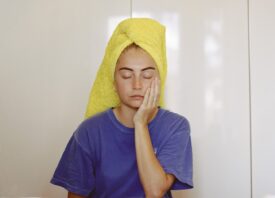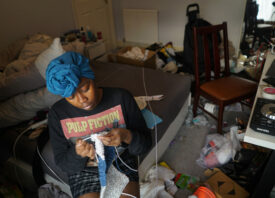Search this site
A Searing Look at Zoonotic Disease Beyond Covid-19
The Wellcome Photography Prize 2021 is free to enter and open for submissions. They’re looking for the human stories behind three urgent health challenges: mental health problems, infectious diseases, and global heating.
Feature Shoot Media has partnered with the Wellcome Photography Prize 2021 to encourage professional, amateur, and student photographers to submit and help raise awareness of the most important health challenges of our time.
This year’s awards feature a new theme: Fighting Infections. During the open call, we’re featuring work from extraordinary photographers exploring these topics; here, we interview the renowned photojournalist Lynn Johnson about her work covering zoonotic diseases.
“I asked Norbert many times if it was okay to photograph him,” the photojournalist Lynn Johnson remembers of her time covering zoonotic diseases for National Geographic. Norbert was a young man living in the Congo; he had contracted monkeypox after eating meat that his cousin had picked up from the forest floor, and by the time he met Johnson, he was already quite ill. “I explained the nature of its magazine and its reach,” she tells us. “I asked his permission, again and again, with language and eyes. Every time, he said yes.
“I visited him in his village, I believe, three times, the first quite late at night after a rather harrowing ride into the bush on the back of a motorcycle—many hours through mud and jungle in pitch black. It was difficult to see him by flashlight and the ‘guide’ was treating him as a specimen, not a human being who was suffering and close to death.
“So, I asked to visit again when there was a more sensitive translator or helper available. I returned in the day with the researcher I was also documenting, trying to balance documenting her work but constantly drawn to being with Norbert. Most of the images were made in Norbert’s mother’s hut. His cousin was also there helping to care for him. It was difficult for him to speak with those horrible pustules all over his body inside and out. But we managed to communicate.
“After over 35 years of being a photographer, I believe that people say ‘yes’ for very few reasons—because one has built a relationship based on trust and collaboration or because the person on the other side of the camera understands that through sharing their story and image, they can help deepen understanding in those they will never meet. Certainly, this was the case with Norbert.”
Johnson traveled throughout the United States, Congo, Indonesia, Bangladesh, and Australia for the Zoonotic Disease project; the magazine gave her plenty of time to make connections and research the subject in-depth, and she estimates she spent about three months in the field on and off. “Of course, the issue is even more relevant today than it was then, with all the concern about the way diseases routinely move across the human-animal barrier,” she says. “In 2007, zoonotic disease was just language. Now it is a painful reality visiting every community in the world.”
Throughout the project, Johnson came face-to-face with the brutal realities of our relationship with animals and the consequences of unnatural contact between species, wrought by man-made environmental degradation and the mistreatment of wildlife. “One of the most challenging pieces of this story was the mindless brutality of humans toward animals caged and starving in the sprawling markets—particularly in Indonesia,” she says. “It is always challenging to look another person or suffering animal in the eye.
“We humans so often live in ignorance and denial about our relationship with animals and the impact of living in closer and closer proximity. In many countries, humans and animals drink from the same water source, hunt the same prey, and live in the same house. Traditions and cultural mores keep us intertwined and therefore at risk for sharing, transforming, and amplifying disease. Most often, it is simply a matter of survival. At the time of this story, we in the developed world; were just beginning to live in fear of microbes traveling across time and space. But those who live in the developing world live with these microbes every moment of the day.”
The photographer stayed safe during her time in the field by listening to the experts, but she knew it carried a degree of risk. After work that day in Norbert’s mother’s hut, she changed her clothes, washed them on a rock, and let them dry in the sun until they were ready to be worn the next day.
Looking back, Johnson tells us, “At the time, this was an assignment, not a passion. Of course, assignments can become passions, and after working on a project like this, it’s difficult to wash it out of your system.” When Covid-19 hit, she went back into the field again, this time close to home.
“With the help of a small grant from National Geographic Society, I’m documenting the less dramatic and often less visible ramifications of Covid on rural health systems, at least a quarter of which will close in the U.S. due to financial losses,” she says. “The stresses seem to be not just Covid but a mental health crisis. Isolation, delay of treatment, lack of all manner of resources is degrading access to all health care at an alarming rate.”
It’s been nearly fifteen years since she first documented zoonotic disease, but it’s followed her throughout countless stories and assignments: “It is stories like this that make one understand that all stories are woven together.
“We are now the developing world. Neither status and wealth nor education will protect us. It is humbling. We have been deeply distracted by the politics in the U.S. and this has cost and will continue to cost lives. For me, the most critical question is how can we narrow this divide so we can fight, not just zoonotic diseases, but diseases of prejudice as well. They are intertwined, and both are deadly.”
Johnson’s in the field right now, and we’re communicating via email whenever she has time. “Working to tell stories, even complicated and emotional stories, is my life,” she says. When asked about the most powerful memory she has of her time photographing zoonotic diseases, she responds with a name: “Norbert.” He died about six months after they met of complications related to monkeypox.
“You know, photographers are taught to be ‘objective,’ not to get involved but work from arm’s length emotionally,” she tells us. “But I no longer believe we have to subvert our humanity to tell stories that have power and are grounded in integrity. In Norbert’s mother’s hut, I realized that part of his pain could be helped by better hydration. I knew that the scientific team was carrying IV bags of fluid and there was a nurse with the team who could start an IV. I asked the nurse to do so, and the fluid helped him survive that moment of crisis.” Of course, she’d make the same decision today.
The Wellcome Photography Prize 2021 is free and open for entries. In addition to two other timely topics–Managing Mental Health and Health in a Heating World–the £26,000 prize will include a Fighting Infections theme as part of their call for submissions. Two overall winners across all topics will receive £10,000 each, while six category winners will bring home £1,000.
In 2020, the novel coronavirus has disrupted life globally; the Fighting Infections category includes images relating to Covid-19 and all other infectious diseases. Wellcome’s judges will be looking for stories about how communities are battling infection; they want images that show how the pandemic has helped bring attention to infectious disease response and how it’s obscured other outbreaks taking place in communities worldwide. During this crucial moment, they’ll look to highlight personal stories as well as political actions.
Feature Shoot Media has partnered with the Wellcome Photography Prize to encourage further discussion of these critical topics and inspire photographers to share their work. Submissions are open through January 18th, 2021.
SUBMIT YOUR PHOTOS FOR FREE HERE.



